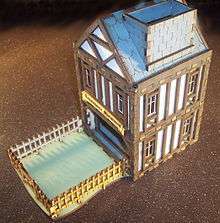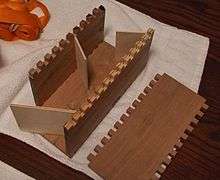Dice tower
A dice tower is an object used by gamers to roll dice fairly. Dice are dropped into the top of the tower, and bounce off of various hidden platforms inside it before emerging from the front. Dice towers eliminate some methods of cheating which may be performed when rolling dice by hand. There are many forms of towers and they vary in construction and design.


History
Dice towers have been used since at least the fourth century, in an attempt to ensure that dice roll outcomes were random.[1] The Vettweiss-Froitzheim Dice Tower is a surviving example, used by Romans in Germany and has essentially the same design as modern examples with internal baffles to force the dice to rotate more randomly.
Construction
Dice towers can be constructed fairly easily.[2] The main elements of a dice tower include:
- the tower itself, a hollow, vertical rectangular prism with projections along the side (often called 'baffles') to sufficiently tumble the dice in order to achieve a random result
- a ramp at the bottom which spills the dice from the inside of the tower
- a small tray, into which the dice come to rest, usually bordered by a short lip to prevent the dice from exiting and disrupting the game or going astray
Usage

The dice are dropped into the top of the tower and bounce off of several interior ramps before emerging from an opening at the base of the tower. Some dice towers include a walled off area for the dice to land in so that they are not scattered across the table.
In tournament backgammon, a dice tower, often referred to as a dice tumbler, is commonly used to ensure fairness by reducing the possibility of a player's intentional influence on the roll.
References
- MacDonald, James (18 February 2018). "The Ancient Origins of Dice | JSTOR Daily". JSTOR Daily.
- Booker, Logan (20 November 2016). "Make Your Own Dice Tower For Board Games And Role-Playing". Lifehacker Australia.